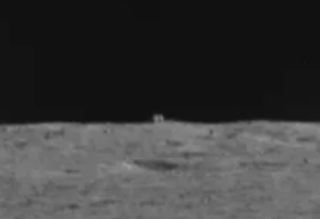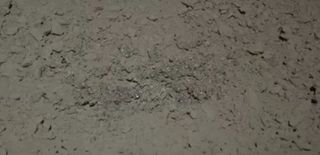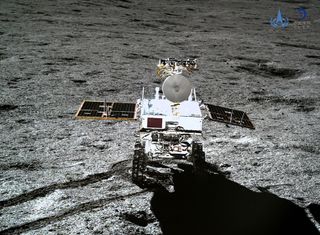'Mystery hut' on the moon just the latest weird lunar find by China's Yutu 2 rover
The buzz-generating 'mystery hut' isn't the only intriguing thing Yutu 2 has spotted.

China's Yutu 2 rover is the first spacecraft to explore the surface of the moon's far side, and the wheeled robot has made some interesting discoveries during its historic journey.
Yutu 2 landed in Von Kármán crater atop the Chang'e 4 lander in January 2019 and has been working its way northwest during each 14.5-Earth-day-long lunar day ever since, using its four science payloads to image and analyze its surroundings as it goes.
The solar-powered rover recently spotted a weirdly cube-shaped 'mystery hut' on its horizon that has generated quite a bit of media buzz, despite most likely being just a rock. But other findings have also drawn attention over the past couple of years.
Photos: Here's what China's Yutu 2 rover found on far side of the moon
'Gel-like' moon discovery and rocks
Yutu 2 discovered an object in the middle of a small crater that was initially described by Our Space — a Chinese-language science outreach channel affiliated with the China National Space Administration — by the term "胶状物" ("jiao zhuang wu"), which can be translated as "gel-like." There was no accompanying image.
Outside scientists suspected the substance was glassy material created by an impact, and that turned out to be correct. A recent paper in the journal Nature authored by Chinese scientists reported that the material was likely from a meteorite strike on the moon less than one million years ago.

Yutu 2 rover and the 'milestone' rock
Another discovery was a number of shards of rock sticking out of the surface, referred to by Our Space as a "milestone." Once again, a meteor impact is the likely culprit.
Get the Space.com Newsletter
Breaking space news, the latest updates on rocket launches, skywatching events and more!
While seemingly mundane, such rocks stand out on a surface that has been pulverized over billions of years by both micrometeorites and harsh solar radiation. When Yutu 2 discovers sizable rocks, they're generally indicators of impact activity. Such rocks provide clues about the history of the moon and the composition of material excavated or ejected by impactors, as was the case with a set of relatively young rocks discovered in early 2020.

Yutu 2 has also been peeking beneath the lunar surface, using its ground-penetrating radar to build an image of layers beneath the rover by collecting reflected electromagnetic waves. Yutu 2 detected three distinct layers in the near subsurface, suggesting that separate, large impact events had delivered ejecta into the region.
The fuzzy image of the "mystery hut" left some people wondering about the quality of Yutu 2's photographic gear. However, the rover's pair of panoramic cameras have returned a huge batch of impressive images from the lunar far side.
The lunar far side never faces Earth; it was not seen until the Soviet Union's Luna 3 spacecraft traveled around the moon in 1959. Chang'e 4 and Yutu 2 therefore cannot beam data directly to Earth and are supported by a relay satellite beyond the moon, which facilitates communications between the spacecraft and its handlers. The relay satellite, known as Queqiao, also collects some data of its own, using a pioneering low-frequency astronomy instrument.

So far, Yutu 2 and its Chang'e 4 lander have been active for over 1,000 (Earth) days on the far side of the moon. Yutu 2 has set a new longevity record for a rover working on the lunar surface, surpassing the previous record of 321 days set by the Soviet Union's robotic Lunokhod 1 rover.
Yutu 2 and Chang'e 4 are currently in their 37th lunar day (each of which is around 29.5 Earth days). The two solar-powered spacecraft hibernate during the two-week-long lunar nights, when the temperature plummets as low as minus 310 degrees Fahrenheit (minus 190 degrees Celsius).
The image of the "mystery hut" was taken during lunar day 36, in November 2021. It's possible that the China Lunar Exploration Program will release new images in the weeks following the end of lunar day 37, which will come on the evening of Dec. 10. Yutu 2 travels an average of roughly 66 feet to 98 feet (20 to 30 meters) per lunar day, meaning the rover is expected to cover the approximately 260 feet (80 m) to the object by lunar day 38 or 39.
Follow us on Twitter @Spacedotcom or on Facebook.
Join our Space Forums to keep talking space on the latest missions, night sky and more! And if you have a news tip, correction or comment, let us know at: community@space.com.

Andrew is a freelance space journalist with a focus on reporting on China's rapidly growing space sector. He began writing for Space.com in 2019 and writes for SpaceNews, IEEE Spectrum, National Geographic, Sky & Telescope, New Scientist and others. Andrew first caught the space bug when, as a youngster, he saw Voyager images of other worlds in our solar system for the first time. Away from space, Andrew enjoys trail running in the forests of Finland. You can follow him on Twitter @AJ_FI.
